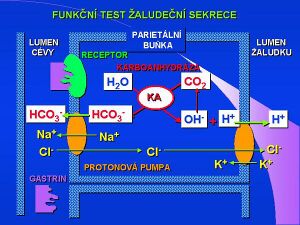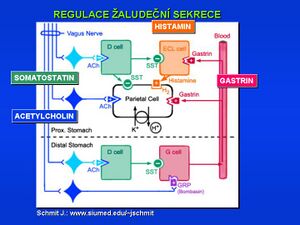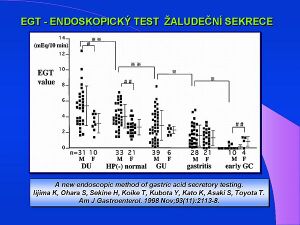Measurement of gastric acid secretion
Parietal cells of the gastric mucosa produce hydrochloric acid at a concentration of about 0.5 mmol/l. The source of the hydrogen ion H+ is water, which is dissociated by membrane hydrolysis in conjunction with the carbonic anhydrase reaction producing CO2. Carbonic anhydrase is a limiting factor for HCl production in the gastric mucosa. Regulation of gastric secretion is controlled by neurohumoral mechanisms, a significant factor is the level of gastrin. Investigation of gastric acidity is based on stimulation of parietal cells, collection of gastric juice, and determination of free and total HCl content. Pentagastrin is the most suitable for stimulation, histamine (Lambling's test) or insulin can also be used. However, the evaluation of the functional test depends on the type of stimulation, ie the result differs after the administration of gastrin, histamine, or insulin.
Test Procedure[edit | edit source]
The patient arrives on an empty stomach and has a gastric tube, the position of which must be verified by sciascopy. The gastric contents are pumped out using a suction pump and the individual portions are collected after 15 minutes, for a total of 2 hours. First, all gastric juice is taken on an empty stomach - portion T0 – and then followed by the collection of unstimulated, basal secretion T60 4 × 15 minutes. After 1 hour of the test, 6 µg pentagastrin/kg body weight is stimulated subcutaneously (histamine is administered as a 1% solution at a dose of 0.1 ml/10 kg body weight, insulin is also administered at 10–20 IU NI). This is followed by another 4 servings after 15 minutes - stimulated T120 secretion.
Laboratory analysis[edit | edit source]
We measure pH volume and titrate HCl concentration in all portions. Titrate 10 ml (minimum 5 ml) of gastric juice with 0.1 mol/l NaOH in the presence of a colored pH indicator (eg diethylaminoazobenzene). Determine the HCl concentration in each fraction, calculate the total HCl output and the secretion rate mmol HCl/hour. The indices used in the diagnosis are designated BAO (Basal acid output), determined from the basal fraction T60 before stimulation; PAO (Peak acid output) determined by the average of the two fractions with the highest concentration of HCl and MAO (Maximum acid output) as a result of hourly stimulated T120 secretion. Pepsin concentrations such as BPO (Basal pepsin output) and MPO (Maximal pepsin output) are also determined in the insulin test.
Pentagastrin test reference values: BAO 1–5 mmol HCl/hr, MAO 10–23 mmol HCl/hr, PAO 8–40 mmol HCl/hr. Values in men are higher than in women (PAO in men is 11–40, in women 8–33 mmol HCl/hr). After stimulation with histamine, we evaluate the total volume of gastric juice, normal values are 150–250 ml/2 hours and total acidity 72–80 mmol HCl/l. Insulin test values in men are BPO 32 ± 29 mg/hod, MPO 320 ± 170 mg/hour; in women BPO 60 ± 81 mg/hour, MPO 170 ± 150 mg/hour.
The clinical significance[edit | edit source]
Hypochlorhydria (hypoacidity) to achlorhydria (anacidity) is a significant symptom of pernicious anemia, suspected malignancies (however, gastric cancer shows hyperacidity and normoacidity in the early stages). The determination of gastric acidity in Zollinger-Ellison syndrome, is diagnostically important, when we demonstrate high basal and maximal secretion (BAO > 15 mmol/hour, MAO > 60 mmol/hour), in more than 50 % of cases of Zollinger-Ellison syndrome the BAO/MAO index is > 0.60. Pentagastrin stimulation of the test is also applicable for mucin analysis. Recent studies use the bQRT test (Blood Quininium Resin Test) to determine hypochlorhydria.
Endoscopic function test variants[edit | edit source]
Stimulation is performed with 4 μg tetragastrin/kg body weight subcutaneously, a 10-minute secretion is collected by an endoscopic probe (20–30 min after stimulation) and acidity is determined by titration in mmol/10 min. The correlation with MAO-BAO is r = 0.92, CV reproducibility = 5.6 %.
References[edit | edit source]
Source[edit | edit source]
- with the permission of the author taken from KOCNA, Petr. GastroLab: MiniEncyclopedia of laboratory methods in gastroenterology [online]. © 2002. Last revision 2011-01-08, [cit. 2011-03-04]. < http://www1.lf1.cuni.cz/~kocna/glab/glency1.htm >.
Bibliography[edit | edit source]
- DERAKHSHAN, MH, et al. Gastric histology, serological markers and age as predictors of gastric acid secretion in patients infected with Helicobacter pylori. J Clin Pathol. 2006, vol 59, no. 12, pp. 1293-9, ISSN 0021-9746 (Print), 1472-4146 (Electronic). PMID: 16644877 .
- DE MARTEL, C, et al. Validation of the blood quininium resin test for assessing gastric hypochlorhydria. Dig Dis Sci. 2006, vol 51, no. 1, pp. 84-8, ISSN 0163-2116 (Print), 1573-2568 (Electronic). PMID: 16416217 .
- HAMILTON, MA, et al. The relationship between a pentagastrin-stimulated gastric luminal acid production test (Gastrotest) and enteral feeding-related gastrointestinal complications in critically ill patients. Anesth Analg. 2005, vol. 100, no. 5, pp. 1447-52, ISSN 0003-2999 (Print), 1526-7598 (Electronic). PMID: 15845703 .
- SKOCZYLAS, T, et al. Significant enhancement of gastric mucin content after rabeprazole administration: its potential clinical significance in acid-related disorders. Dig Dis Sci. 2003, vol 48, no. 2, pp. 322-8, ISSN 0163-2116 (Print), 1573-2568 (Electronic). PMID: 12643610 .
- HAYAKAWA, T, et al. Enhanced somatostatin secretion into the gastric juice with recovery of basal acid output after Helicobacter pylori eradication in gastric ulcers. J Gastroenterol Hepatol. 2003, vol. 18, no. 5, pp. 505-11, ISSN 0815-9319 (Print), 1440-1746 (Electronic). PMID: 12702041 .
- KALACH, N, et al. Correlation between gastric acid secretion and severity of acid reflux in children. Turk J Pediatr. 2003, vol 45, no. 1, pp. 6-10, ISSN 0041-4301 (Print). PMID: 12718363 .
- HYRDEL, R, et al. Diagnosis of the Zollinger-Ellison syndrome. I: Significance of anamnestic, clinical and laboratory examinations. Inside Lek. 2002, vol 48, no. 6, pp. 567-72, ISSN 0042-773X (Print). PMID: 12132362 .
- ROY, PK, et al. Gastric secretion in Zollinger-Ellison syndrome. Correlation with clinical expression, tumor extent and role in diagnosis - a prospective NIH study of 235 patients and a review of 984 cases in the literature. Medicine (Baltimore). 2001, vol 80, no. 3, pp. 189-222, ISSN 0025-7974 (Print), 1536-5964 (Electronic). PMID: 11388095 .
- METZ, DC, et al. A retrospective study of the usefulness of acid secretory testing. Aliment Pharmacol Ther. 2000, vol. 14, no. 1, pp. 103-11, ISSN 0269-2813 (Print), 1365-2036 (Electronic). PMID: 10632653 .
- IIJIMA, K, et al. A new endoscopic method of gastric acid secretory testing. Am J Gastroenterol. 1998, vol 93, no. 11, pp. 2113-8, ISSN 0002-9270 (Print), 1572-0241 (Electronic). PMID: 9820382 .
- HURLIMANN, S, et al. Effects of Helicobacter pylori on gastritis, pentagastrin-stimulated gastric acid secretion, and meal-stimulated plasma gastrin release in the absence of peptic ulcer disease. Am J Gastroenterol. 1998, vol 93, no. 8, pp. 1277-85, ISSN 0002-9270 (Print), 1572-0241 (Electronic). PMID: 9707051



